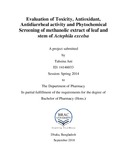Evaluation of toxicity, antioxidant, antidiarrheal activity and phytochemical Screening of methanolic extract of leaf and stem of actephila excelsa
Abstract
For a long time, human is seeking thoroughly for natural medicines to treat different types of diseases. Disregarding the expansion of synthetic drugs to treat incessant disease, the exploitation of natural medicines keeps on thriving. The plant Actephilaexcelsabelongs to the family Phyllanthaceae. For this research, stem and leaf of Actephila excelsa were preferred to evaluate its antioxidant, antidiarrheal properties as well as the toxicological activities and phytochemical screening. The primary reason behind choosing this plant is that the dried out leaves of the plant are commonly used to make tasty tea. So, it could be rich with phytochemicals and antioxidants. The secondary reason is that no study still has been carried out to identify its biological properties. In this study, to establish the antioxidant properties in-vitro DPPH free radical scavenging, total phenolic content and total flavonoid content determination were carried out. Antidiarrheal (castor oil and MgSO4) and toxicological activities were performed in vivo using Swiss albino rats. The study defined strong DPPH scavenging activity and total phenolic content but mild flavonoid content. The phytochemical constituents (Carbohydrates, alkaloids, flavonoids, tannins, saponins) were present. The leaf extract showed high antidiarrheal potentials. It showed significant difference in various organ parts for both leaf and stem extracts. In contrast, no significant difference (p <0.05) was noticed in body weights. Significant difference was also observed in WBC, RBC, platelets, neutrophil, lymphocytes, monocytes, PDW, SGPT, SGOT, cholesterol level while performing the histopathological and biochemical examinations. Therefore, after performing the toxicological test it can be decided that the plant is toxic to be used for long period.

